Petrol Fumes Induced Liver Toxicity in Wistar Rats: The Ameliorative Potentials of Rhizophora racemosa stem bark, Bridelia ferruginea and Emilia sonchifolia leaves.

Keywords
Petrol, Liver toxicity, GGT, AST, ALP, ALT, antioxidants, plant extracts.
Full Article
Download Full Article (PDF)How to Cite
Chukwuma Samuel Anakwe; Ogbe Preye David; Appah Williams Weri; The Prophet Prohp4 (2025). Petrol Fumes Induced Liver Toxicity in Wistar Rats: The Ameliorative Potentials of Rhizophora racemosa stem bark, Bridelia ferruginea and Emilia sonchifolia leaves.. SIAR-Global Journal of Medicine & Pharmaceutical Review, Vol. 1, No. 1. DOI: 10.5281/zenodo.17107634